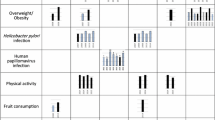Abstract
A randomized double-blind intervention trial was carried determine whether oral calcium supplementation could lower the proliferation of epithelial cells of the esophagus. 41 subjects identified with precanceous lesions by histopathology were randomized to receive oral supplementation of their conventional diets with 0.6 g of calcium as calcium carbonate or placebo. Both at the entry to the study and at the end of the treatment, seven months later, the subjects were examined, with an emphasis on the frequency and distribution of proliferating epithelial cells of the esophagus. Patterns of cell proliferation was defined by dividing the esophageal epithelium into cell olumns oriented perpendicularly to the basal cell layer and by comparing the numbers and fractions of tritiated thymidine-labled epithelial cells in the various cell columns and cell compartments.
Before dietary supplementation with calcium, the profile of proliferating epithelial cells in the esophageal compartments in calcium group is similar to that in the placebo group, which is comparable to that previously observed in subjects with high risk for esophageal cancer. Seven months after supplementation having been started, in calcium group, proliferation was significantly reduced and the profile of the esophageal columns approached to that previously observed in subjects at low risk for esophageal cancer, however, in the placebo group, the proliferation and profile maintain at the same level as that before supplementation. Our findings indicate that oral calcium supplementation induces a more quiescent equilibrium in epithelial-cell proliferation in the esophageal mucosa of the subjects at high-risk for esophageal cancer, similar to that observed in subjects at low risk.
Similar content being viewed by others
References
Lay NE, Munoz N. Esophagus. In: Cancer Epidemiology and Prevention. Schottenfeld D, Fraumeni JF JR eds. Philadelphia, PA: WB Saunders Co. 1982; 596–623.
Jaskiewicz K, et al. Esophageal and other main cancer patterns in four districts of Transki, 1981–1984. S Afr Med J 1987; 72:27.
Wang Lidong, et al. Labeling index and labeling distribution of cells in the esophageal epithelium: A contribution to definition of patients at increased risk for esophageal cancer. Cancer Res 1990; 50:2651.
Yang GC, et al. Proliferation of esophageal epithelial cells among residents of Linxian, China. JNCI 1987; 79:1241.
N Munoz, et al. Proliferative abnormalities of the esophageal epithelium of Chinese populations at high and low risk for esophageal cancer: Int J Cancer 1985; 36:187.
Yang CS. Research on esophageal cancer in China: a review. Cancer Res 1980; 40:2633.
Van Rensburg, SJ. Epidemiological and dietary evidence for a specific nutritional predisposition to esophageal cancer. JNCI 1981; 67:243.

Peto R, et al. Can dietary beta-carotene materially reduce human cancer rate? Nature 1981; 290:201.
Sporn MB, et al. Chemoprevention of cancer with retinoids. Fedn Proc 1979; 38:2528.
Wynder EL, et al. The possible role of riboflavin deficiency in epithelial neoplasia II: Effect on skin tumor development. Cancer 1970; 26:1221.
Barbara CP, et al. In hibition of dietary fatpromoted colon carcinogenesis in rate by supplemental calcium or vitamin D3. Carcinogenesis 1988; 9:187.
John FL, et al. Clonal growth of epithelial cells from normal adult human broachus. Cancer Res 1981; 41:2294.
Babcock MS, et al. Clonal growth and serial propagation of rat esophageal epithelial cells. In Vitro 1983; 19:403.
Van Rensourg SJ, et al. Nutritional status of African populations predisposed to esophageal cancer. Nutr Cancer 1983; 4:206.
Chung SY, et al. The role of micronutrient deficiency in carcinogenesis. In: Critical Reviews in Oncology/hematology. Stephen Davis, ed. Boca Raton, Florida: CRC Press Inc. 1987; 267.
Martin Lipkin, Harild Newmark. Effect of added dietary calcium on colonic epithelial-cell proliferation in subjects at high risk for familial colonic cancer. N Engl J Med 1985; 313:1381.
Newmark RL, et al. Colon cancer and dietary fat, phosphate, and calcium a hypothesis. JNCI 1984; 72:1323.
Mary C, et al. Clonal growth of normal human epidermal keratinocytes in a defined medium. J Cellular Physiology 1982; 110:219.
Hennings H, et al. Calcium regulation of growth and differentiation of mouse epidermal cells in culture. Cell 1980; 19:245.
Author information
Authors and Affiliations
Rights and permissions
About this article
Cite this article
Lidong, W., Liang, Q.S., Guanrui, Y. et al. Effect of added dietary calcium on esophageal epithelial-cell proliferation in subjects at high risk for esophageal cancer: A double-blind intervention study. Chinese Journal of Cancer Research 3, 24–30 (1991). https://doi.org/10.1007/BF02672085
Issue Date:
DOI: https://doi.org/10.1007/BF02672085





